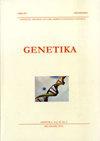妊娠中期常规筛查中染色体畸变的超声标记
4区 农林科学
Q3 Agricultural and Biological Sciences
引用次数: 0
摘要
孕中期超声检查染色体异常的风险评估仍然是产前评估的重要组成部分。我们进行了一项回顾性研究,以评估超声筛查染色体畸变标志物的效率,并根据所发现的畸变对超声标记进行分类。在10年的时间里,我们对620例胎儿血液进行了核型分析,这些血液是在未选择人群的妊娠中期扫描中检测到胎儿异常后通过脐带穿刺采集的,并对216例具有疑似染色体病表型特征的新生儿外周血样本进行了核型分析。超声检查和细胞遗传学数据从实验室数据库获得。染色体异常胎儿36例(5.8%)。最常见的染色体畸变见于多发畸形(13.3%)、心脏畸形(11.5%)、短股骨(12.5%)和羊水过多(7.7%)。超声检查对唐氏综合征的检出率为85%,性染色体三体检出率为80%。18三体、13三体和多倍体在产前各占100%。近42%的21三体胎儿有心脏异常,35.3%羊水过多,17.7%股骨短。18三体胎儿羊水过多占87.5%,中枢神经系统异常占62.5%,对称IUGR占50%。所有X染色体胎儿的股骨都很短。超声评价是在低危人群中发现染色体异常高危胎儿最灵敏的筛查方法。本文章由计算机程序翻译,如有差异,请以英文原文为准。
Ultrasound markers of chromosome aberrations on routine second trimester screening
Second trimester ultrasound examination for risk assessment of chromosomal abnormalities remains an important component of prenatal evaluation. We have conducted a retrospective study to evaluate the efficiency of ultrasonographic screening for the markers of chromosomal aberrations and to classify ultrasonographic markers according to the aberration they were found with. Over a 10 year period we performed 620 karyotype analyses of fetal blood taken by cordocentesis after detection of fetal anomalies in a second trimester scan in unselected population and 216 samples of peripheral blood of neonates having phenotypic features suspected for chromosomopathies. Ultrasound examination and cytogenetic data were obtained from the laboratory database. Chromosomal abnormalities were found in 36 (5,8%) fetuses with anomalies. Most frequently chromosomal aberrations were detected in fetuses with multiple anomalies (13,3%), heart anomalies (11,5%), short femurs (12,5%) and polyhydramnios (7,7%). The success rate of sonographic examination in detection of Down syndrome was 85%, and in detection of sex chromosome trisomies 80%. Trisomy 18, trisomy 13 and polyploidy were found prenatally in 100% each. Nearly 42% of trisomy 21 fetuses had heart anomaly, 35,3% polyhydramnios and 17,7% short femurs. Trisomy 18 fetuses had polyhydramnios in 87,5%, CNS anomalies in 62,5% and symmetrical IUGR in 50% of cases. All of the fetuses with monosomy X had short femurs. Ultrasonographic evaluation is the most sensitive screening method for the identification of fetuses having a high risk rate for chromosomal abnormalities in a low risk population.
求助全文
通过发布文献求助,成功后即可免费获取论文全文。
去求助
来源期刊

Genetika-Belgrade
AGRONOMY-GENETICS & HEREDITY
CiteScore
1.80
自引率
0.00%
发文量
1
审稿时长
6-12 weeks
期刊介绍:
The GENETIKA is dedicated to genetic studies of all organisms including genetics of microorganisms, plant genetics, animal genetics, human genetics, molecular genetics, genomics, functional genomics, plant and animal breeding, population and evolutionary genetics, mutagenesis and genotoxicology and biotechnology.
 求助内容:
求助内容: 应助结果提醒方式:
应助结果提醒方式:


